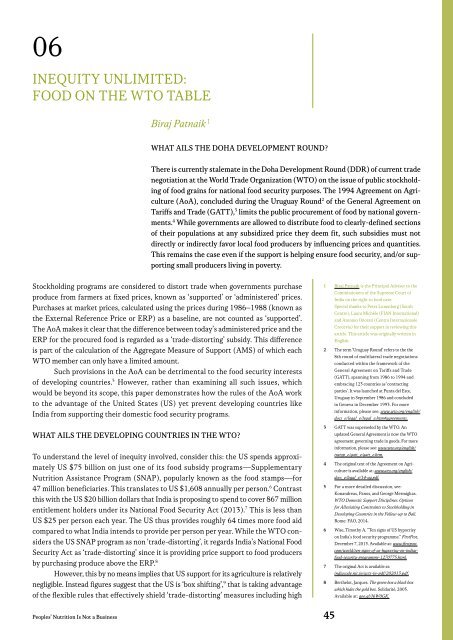RIGHT TO FOOD AND NUTRITION WATCH
1iNBHTY
1iNBHTY
Create successful ePaper yourself
Turn your PDF publications into a flip-book with our unique Google optimized e-Paper software.
06<br />
INEQUITY UNLIMITED:<br />
<strong>FOOD</strong> ON THE W<strong>TO</strong> TABLE<br />
Biraj Patnaik 1<br />
WHAT AILS THE DOHA DEVELOPMENT ROUND?<br />
There is currently stalemate in the Doha Development Round (DDR) of current trade<br />
negotiation at the World Trade Organization (W<strong>TO</strong>) on the issue of public stockholding<br />
of food grains for national food security purposes. The 1994 Agreement on Agriculture<br />
(AoA), concluded during the Uruguay Round 2 of the General Agreement on<br />
Tariffs and Trade (GATT), 3 limits the public procurement of food by national governments.<br />
4 While governments are allowed to distribute food to clearly-defined sections<br />
of their populations at any subsidized price they deem fit, such subsidies must not<br />
directly or indirectly favor local food producers by influencing prices and quantities.<br />
This remains the case even if the support is helping ensure food security, and/or supporting<br />
small producers living in poverty.<br />
Stockholding programs are considered to distort trade when governments purchase<br />
produce from farmers at fixed prices, known as ‘supported’ or ‘administered’ prices.<br />
Purchases at market prices, calculated using the prices during 1986–1988 (known as<br />
the External Reference Price or ERP) as a baseline, are not counted as ‘supported’.<br />
The AoA makes it clear that the difference between today’s administered price and the<br />
ERP for the procured food is regarded as a ‘trade-distorting’ subsidy. This difference<br />
is part of the calculation of the Aggregate Measure of Support (AMS) of which each<br />
W<strong>TO</strong> member can only have a limited amount.<br />
Such provisions in the AoA can be detrimental to the food security interests<br />
of developing countries. 5 However, rather than examining all such issues, which<br />
would be beyond its scope, this paper demonstrates how the rules of the AoA work<br />
to the advantage of the United States (US) yet prevent developing countries like<br />
India from supporting their domestic food security programs.<br />
WHAT AILS THE DEVELOPING COUNTRIES IN THE W<strong>TO</strong>?<br />
To understand the level of inequity involved, consider this: the US spends approximately<br />
US $75 billion on just one of its food subsidy programs—Supplementary<br />
Nutrition Assistance Program (SNAP), popularly known as the food stamps—for<br />
47 million beneficiaries. This translates to US $1,608 annually per person. 6 Contrast<br />
this with the US $20 billion dollars that India is proposing to spend to cover 867 million<br />
entitlement holders under its National Food Security Act (2013). 7 This is less than<br />
US $25 per person each year. The US thus provides roughly 64 times more food aid<br />
compared to what India intends to provide per person per year. While the W<strong>TO</strong> considers<br />
the US SNAP program as non ‘trade-distorting’, it regards India’s National Food<br />
Security Act as ‘trade-distorting’ since it is providing price support to food producers<br />
by purchasing produce above the ERP. 8<br />
However, this by no means implies that US support for its agriculture is relatively<br />
negligible. Instead figures suggest that the US is ‘box shifting’, 9 that is taking advantage<br />
of the flexible rules that effectively shield ‘trade-distorting’ measures including high<br />
1 Biraj Patnaik is the Principal Adviser to the<br />
Commissioners of the Supreme Court of<br />
India on the right to food case.<br />
Special thanks to Peter Lunenborg (South<br />
Centre), Laura Michéle (FIAN International)<br />
and Antonio Onorati (Centro Internazionale<br />
Crocevia) for their support in reviewing this<br />
article. This article was originally written in<br />
English.<br />
2 The term ‘Uruguay Round’ refers to the the<br />
8th round of multilateral trade negotiations<br />
conducted within the framework of the<br />
General Agreement on Tariffs and Trade<br />
(GATT), spanning from 1986 to 1994 and<br />
embracing 123 countries as ‘contracting<br />
parties’. It was launched at Punta del Este,<br />
Uruguay in September 1986 and concluded<br />
in Geneva in December 1993. For more<br />
information, please see: www.wto.org/english/<br />
docs_e/legal_e/legal_e.htm#agreements.<br />
3 GATT was superseded by the W<strong>TO</strong>. An<br />
updated General Agreement is now the W<strong>TO</strong><br />
agreement governing trade in goods. For more<br />
information, please see: www.wto.org/english/<br />
tratop_e/gatt_e/gatt_e.htm.<br />
4 The original text of the Agreement on Agriculture<br />
is available at: www.wto.org/english/<br />
docs_e/legal_e/14-ag.pdf.<br />
5 For a more detailed discussion, see:<br />
Konandreas, Panos, and George Mermigkas.<br />
W<strong>TO</strong> Domestic Support Disciplines: Options<br />
for Alleviating Constraints to Stockholding in<br />
Developing Countries in the Follow-up to Bali.<br />
Rome: FAO, 2014.<br />
6 Wise, Timothy A. “Ten signs of US hypocrisy<br />
on India’s food security programme.” FirstPost,<br />
December 7, 2013. Available at: www.firstpost.<br />
com/world/ten-signs-of-us-hypocrisy-on-indiasfood-security-programme-1270775.html.<br />
7 The original Act is available at:<br />
indiacode.nic.in/acts-in-pdf/202013.pdf.<br />
8 Berthelot, Jacques. The green box a black box<br />
which hides the gold box. Solidarité, 2005.<br />
Available at: goo.gl/I6W0GK.<br />
Peoples’ Nutrition Is Not a Business 45


